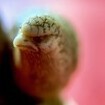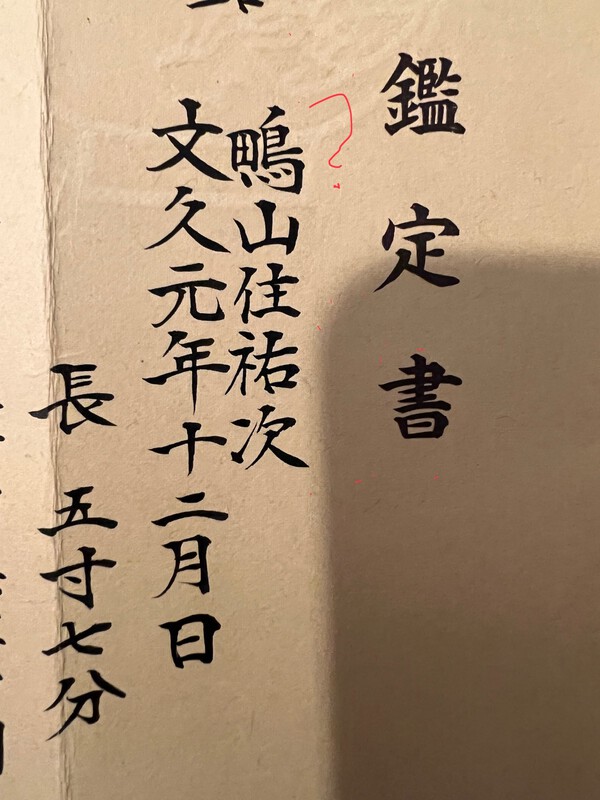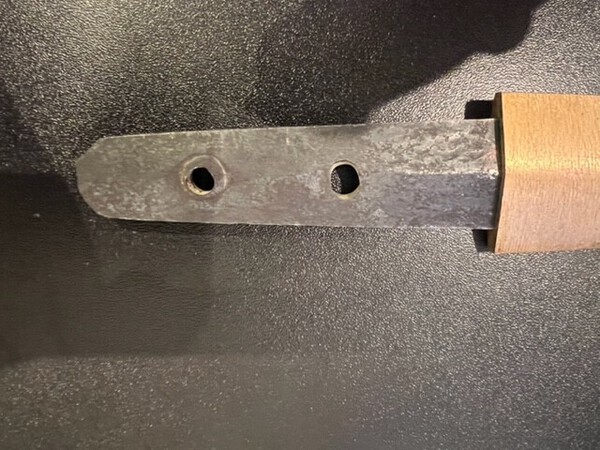-
Posts
45 -
Joined
-
Last visited
Content Type
Profiles
Forums
Events
Store
Downloads
Gallery
Everything posted by JAL
-
Thank you Steve, best regards John
-
Thanks John, yes, my mistake, of course, preceding the 258. I am looking for the province where it was issued. best regards John L.
-
Hi all, The attached Torokusho gives me issues. The blue circled mei is difficult for me to read. The other blue part should be the province where the torokusho was issued? attached the TH paper cross-referencing the torokusho. Mei Kanematsu (Seki). any help would be appreciated. The rest of the torokusho I can mostly handle. best regards John L.
-
-
I tried to find info about this smith (Bunkyu Gan nen nengo) but can only find 1801-1804 refercence.
-
Might be Shigi yama jyu Suketsugu?
-
Hi all, on this Tokubetsu Hozon paper I am struggling with the first kanji of the mei. Kamo? The rest seems to me yama jyu Suketsugu Bunkyu 1. thanks for any help, John L.
-
Dutch customs took a long time after Grev’s quick dispatch, but finally I received the Musashi Namako tsuba. Very nice! best regards John L.
-
Hi Ron, congratulations! I have a juyo (den) Cho Aritoshi that I really enjoy. See attached. My assumption also based on the settsu-mei has been that there were two generations Aritoshi with Cho Aritoshi being the second generarion. I have not finalized the translation in full but most of it is attached with help of a Japanese friend who is not a nihonto student so I need to edit some terminology still. Description It is said that Aritoshi was a swordmaker belonged to Yamato taima (or taema) school and he has two names: one is Aritoshi (有俊) consisting of two Chinese characters and another is Cho Aritoshi (長有俊) consisting of three Chinese characters. The former one can be seen produced in Einin 6 (1298). It is a common theory that mei of Cho Aritoshi (three Chinese characters) shows the second Aritoshi, the era is approx. Kenmu, shortened name of Chobei (no) jo Aritoshi. This sword is that jigane is koitame with slightly nagare masa, thick jinie sticked to pieces, hamon is suguha, kochoji, kogunome, kui chigai ba & niju ba & yubashiri on habuchi, thick nie is brightly saeru, etc, significantly see Cho Ariyoshi’s feature on jiba (jihada and hamon) and kiwameno syuko sareru (it is proved as the past authentication.). As Cho Ariyoshi’s feature, habuchi is a highlight of niju ba. This sword has strong hanie with Cho Aritoshi’s kiwame, niju ba with thick and condensed nie can be frequently seen on habuchi, hamon is clearly skillful. It is an excellent piece of work the sayagaki of Tanobe san does not mention it specifically: Sayagaki Tanobe Sensei 62th juyo token The Wasyu Cho Aritoshi. This sword is Osuriage Mumei. This sword smith was Taima school’s student, he was a sword smith in the Kenmu era. Hamon is Suguha and chogunome with deep and thick Nie. Also, Hamon has many Niju- ba and Yubashiri. This sword has a lot of characteristics of Aritoshi and is excellent. Nagasa 2 shaku 2 sun 2 bu Year of the Rooster 2017 enjoy your new acquisition! best regards John 62th Juyo Token.docx
-
Thank you Steve! Some of the peculiarities are so difficult to grasp. Thanks for your quick answer. best regards John
-
-
Dear all, I am having trouble as usual with Tanobe san’s kanji. The total sayagaki I could translate but in this important part I miss the clue to some kanji. Any help would be appreciated. Best regards John L.
-
Thanks Geraint, yes, I think they are silver-plated brass looking at the wear. Nice ken as well. I agree that it might indeed be export in Meiji times. best regards John
-
-
Hi all, this ken puzzles me a bit. It is large with a nagasa of 69 cm. Nice masame hada and suguha hamon. The mounts are different from what I have seen with traditional ken that have a vajra as tsuka. Given the elaborate mounts with a lacquered tsuka I assume this ken was ceremonial (Dharma wheel also represented a couple of times on the mounts) and not a weapon. My estimation is Bakumatsu assuming the Aoi mon are original. Meiji would be a bit strange with aoi mon on all of the mounting. It still puzzles me. best regards John L.
-
Hi, Setsumei translstion best effort. Description It is said that Aritoshi was a swordmaker belonged to Yamato Taima school and he has two names: one is Aritoshi (有俊) consisting of two Chinese characters and another is Cho Aritoshi (長有俊) consisting of three Chinese characters. The former one can be seen produced in Einin 6 (1298). It is a common theory that mei of Cho Aritoshi (three Chinese characters) shows the second Aritoshi, the era is approx. Kenmu, shortened name of Chobei (no) jo Aritoshi. This sword is that jigane is koitame with slightly nagare masa, thick jinie sticked to pieces, hamon is suguha, kochoji, kogunome, kui chigai ba & niju ba & yubashiri on habuchi, thick nie is brightly saeru, etc, significantly see Cho Aritoshi’s feature on jiba (jihada and hamon) and kiwameno syuko sareru (it is proved as the past authentication.). As Cho Aritoshi’s feature, habuchi is a highlight of niju ba. This sword has strong hanie with Cho Aritoshi’s kiwame, niju ba with thick and condensed nie can be frequently seen on habuchi, hamon is clearly skillful. It is an excellent piece of work. best regards, John
-
Sayagaki of my Taima Den Cho Aritoshi states the smith being active in Kenmu era (1333-1336 so Nambokucho).
-
-
Hi all, here are some pictures of the sayagaki of my Taima. Translation in earlier post. I was not really looking for specifically Taima, but did at that time have a vested interest in Yamato. Still own a TH Kamakura tachi, a juyo Senjuin Yoshimitsu Kamakura tanto and this Taima Cho Aritoshi. best regards John
-
Hi, Nice Taima sword. Although it is stated that Taima is a somewhat rare school, I owned four blades in during twenty years of collecting and two of them attributed to Cho Aritoshi. Currently I still have in my collection a juyo token attributed to den Cho Aritoshi (62nd juyo session) with a sayagaki by Tanobe sensei which translates approximately to: Sayagaki Tanobe Sensei 62th juyo token The Wasyu Cho Aritoshi. This sword is Osuriage Mumei. This sword smith was Taima school’s student, he was a sword smith in the Kenmu era. Hamon is Suguha and Syogunome with deep and thick Nie. Also, Hamon has many Niju- ha and Yubashiri. This sword has a lot of characteristics of Aritoshi and is excellent. Nagasa 2 shaku 2 sun 2 bu Year of the Rooster 2017 best regards, John
-
Thank you Steve, yess, the length I believe is 2 shaku, 2 sun, 2 bu about 67.3 cm. I am always struggling with the description of the year, but based on your transcription this should be the year of the rooster,, so 2017 which makes sense because the juyo paper is end 2016. best regards, John
-
-
Dear all, The setsu-mei and juyo paper translation are doable but sayagaki is still a problem for me. This is a 60th juyo session yamato Taima Den Cho Aritoshi o-suriage mumei sword Kenmu era. This is as far as I got with the Tanobe -san sayagaki translation but I might not be correct. Any help would be greatly appreciated. ‘’Washu (Yamato Cho Aritoshi. This sword is Osuriage Mumei. This sword smith was Taima school’s student, he was a sword smith in the Kenmu era. Hamon is Suguha and Syogunome with deep and thick Nie. Also, Hamon has many Niju-ha and Yubashiri. This sword has a lot of characteristics of Aritoshi and is excellent.” Best regards, John







































